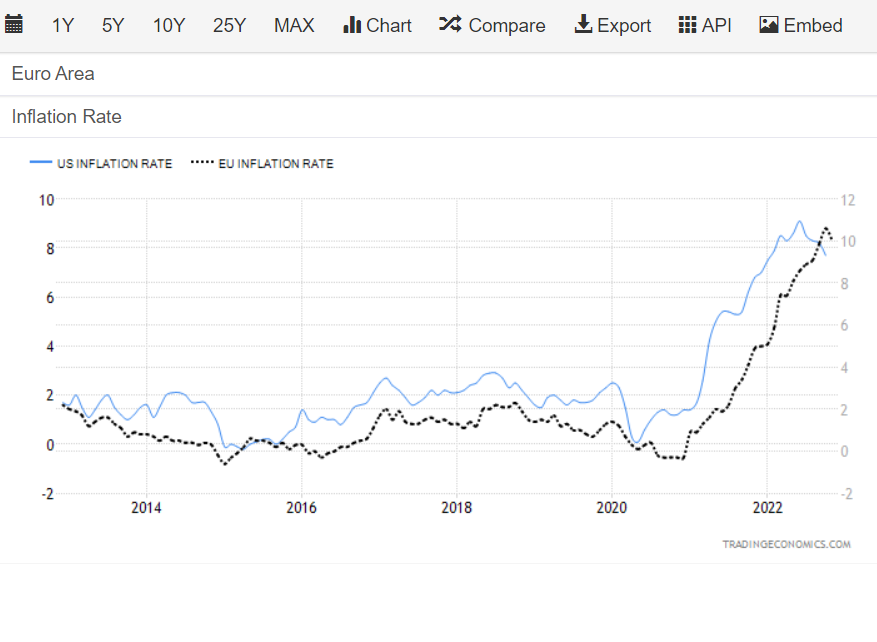2023: How Great is the Risk of Deflation in the Eurozone


Our publication about 2023 inflation expectations for the US has attracted the attention of the media and investors. One intriguing question which we have received stands out in particular: ‘What does this mean for Europe and the Eurozone in particular?’. This is something which needs to be addressed.
In order to perform a similar analysis for Europe, we need better data. Nevertheless, we DO have some data which will allow us to provide a decent answer to the question.
First, let’s have a look at long-term inflation in the US vs. the Eurozone
Data for the last ten years suggests that the Eurozone economies are less inflationary than the US economy. What we are observing at the present moment in a situation where the Eurozone inflation is ABOVE that of the US is an anomaly. It has happened before, but usually, US inflation is about 0.5% higher than that in the Eurozone. This was at a time when inflation was averaging around 2%!
Second, let’s compare M2 in both economies starting from Dec 2019:
| US M2 | Increase % | US (CPI) Inflation | EUR M2 | Increase % | Eurozone (CPI) Inflation | |
| 2019 | 15,319.1 | 12,378 | ||||
| 2020 | 19,124.8 | 24.84% | 1.23% | 13,732 | 10.94% | 0.25% |
| 2021 | 21,489.9 | 12.37% | 4.47% | 14,693 | 7.00% | 2.59% |
| 2022* | 21,415.2 | -0.35% | 8.20% | 15,375 | 4.64% | 12.30% |
| 2019-2022* | 39.79% | 14.43% | 24.21% | 15.50% |
We need to be certain that we are reviewing the numbers in such a way that they are not ‘lost in translation’. For example, in 2020, US M2 increased by 24.84% while US inflation (as measured by CPI) was 1.23%. For the Eurozone, the numbers represent a 10.94% increase in M2 with 0.25% inflation (Eurozone CPI).
Aggregated numbers also deserve attention. From the end of 2019 to Oct 2022, the US M2 increased by 39.79%, with inflation of 14.43%. For the same period, the Eurozone M2 increased by 24.21%, while inflation was 15.50%.
In conclusion, we can say that while the ECB did NOT stop expanding its balance sheet until the middle of 2022, which contributed to inflation in 2022, the overall increase in M2 in the Eurozone was a lot LESS than the increase of M2 in the US. Moreover, we can see that the Eurozone increase in 2022 was only 5% while the Eurozone CPI increased by 12.3%.
The numbers shown above STRONGLY suggest that inflation in the Eurozone in 2022 is not caused ENTIRELY by the expansionary policy of the ECB. It is safe to assume that the war in Ukraine has also been a significant contributor to inflation (maybe even higher than the M2 increase). It is important to note that such exogenous shocks to the economy, while inflationary in the short term, tend, on average, without appropriate monetary accommodations, to be DEFLATIONARY in the long run (Eurozone in 2009—2012 vs. US). This is because on average demand destruction tends to recover MORE SLOWLY than supply.
There is plenty of evidence that the Eurozone economy is doing much worse than the US economy. We will look only at one statistic — Retail Sales, but the conclusions will be similar no matter what we look at:
| US Retail Sales YOY | Eurozone Retail Sales YOY | |
| Jan 2022 | 12.96% | 7.80% |
| Feb 2022 | 17.62% | 5% |
| Mar 2022 | 6.88% | 0.80% |
| Apr 2022 | 8.19% | 3.90% |
| May 2022 | 8.09% | 0.20% |
| Jun 2022 | 8.42% | -3.70% |
| Jul 2022 | 10.02% | -0.90% |
| Aug 2022 | 9.10% | -2% |
| Sep 2022 | 8.41% | -0.60% |
| Oct 2022 | 8.37% | -2.7% |
If we assume that inflation in the US and the Eurozone is on average about 10% in the second half of 2022, US retail sales are roughly keeping track with inflation. However, the Eurozone Retail Sales are solidly decreasing on a YOY comparison. Given that inflation is over 10%, this is a decrease close to 15% in purchasing power comparison! This is what you call demand destruction!
In conclusion, given that M2 in the Eurozone increased much less than M2 in the US and there is strong evidence of demand destruction in Europe, the inflation we see in the Eurozone in 2022 is unlikely to persist. Furthermore, since the ECB is no longer increasing the supply of M2, the most likely logical outcome is to see DEFLATION in the Eurozone in 2023 (especially since we expect inflation in the US at 1.3% in 2023).
Of course, the most crucial factor here is the war in Ukraine. If hostilities get much worse or we see other countries being drawn into the conflict, then this would detract from our analysis. But luck can go either way — things in Ukraine MIGHT get better or at least no worse in 2023.
Get the trading edge you need in today’s markets – sign up for our monthly newsletter featuring in-depth expert analysis, hot market insights, and exclusive trading strategies.
Sources:
Disclaimer:

